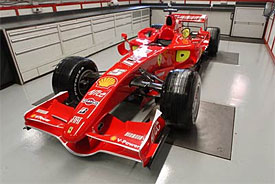 This year's Ferrari F1 car, the F2007, was unveiled on Sunday. The most noteworthy aspect of it is the inclusion, for the first time on a Ferrari, of a 'zero-keel' front suspension.
This year's Ferrari F1 car, the F2007, was unveiled on Sunday. The most noteworthy aspect of it is the inclusion, for the first time on a Ferrari, of a 'zero-keel' front suspension.Back in 1990, Harvey Postlethwaite and Jean-Claude Migeot introduced the Tyrrell 019 (below), the first Formula 1 car to feature a 'raised nose'. The underbody of a F1 car generates a lot of downforce, and the greater the quantity of airflow under the car, the greater this downforce. The rationale of the raised nose is simply to maximise the airflow under the car by removing an obstruction, and the raised nose duly became the norm in F1 over the next decade. However, with the nose raised, the points where the lower front suspension wishbones previously attached to the car no longer existed. The universal solution adopted was to attach the lower wishbones to a single keel, hanging from beneath the raised nose.

Then, in 2001, Sergio Rinland's Sauber introduced the twin-keel solution, in which the lower wishbones on either side attached to their own keel, hanging from the outer underside of the nose. This opened up the central region, enhancing airflow off the front wing and underneath the car. The benefits, however, were not unambiguous; there were both structural limitations, and limitations placed upon the front suspension geometry. Ferrari resolutely stuck with a single keel, and their multiple championship success largely vindicated this decision. However, by 2005, McLaren had taken the twin-keel to its logical conclusion: a zero-keel, in which the lower wishbones are angled upwards, and attach to the lower flanks of the nose. McLaren enjoyed significant success in 2005, and really only lost the championship through poor reliability. However, they struggled in 2006, which begs the question, 'Why have Ferrari chosen to go the zero-keel route for 2007?'
Here is one possible answer. In 2006, engine capacity was reduced by the governing body from 3.0 litres to 2.4 litres. This made the reduction of drag more important, and the rear wing on an F1 car generates far more drag than the front wing. To reduce drag, the teams reduced the angle of incidence of the rear wings, but retained the same amount of downforce by increasing the level of flow to the rear wing. This was done by the clever use of 'flow conditioners' atop the nose, which can adjust the relative amount of airflow the front and rear wings are subject to.
Autosport journalist Mark Hughes reported before Christmas that the new Bridgestone tyres for 2007 are such that the rears suffer worse wear than the fronts, and the fronts are more difficult to warm up. As Hughes points out, this will force the designers to shift the weight distribution and centre of aerodynamic pressure forwards, taking load off the vulnerable rears, and helping to generate heat in the fronts. This change in the centre of aerodynamic pressure will make the front wing more important again, and perhaps justifies the use of a zero-keel.

4 comments:
So that means they can go pretty fast?
These days it means that they can accelerate, decelerate, and change direction pretty fast. Going fast in a straightline is considered a bad thing because it means that the sponsorship livery on the cars, and the trackside advertising banners do not remain in camera-shot for sufficiently long periods of time.
These days it means that they can accelerate, decelerate, and change direction pretty fast. Going fast in a straightline is considered a bad thing because it means that the sponsorship livery on the cars, and the trackside advertising banners do not remain in camera-shot for sufficiently long periods of time.
- this is the most stupid explanation i've ever read.....
You should try to read more often Jeff.
Post a Comment